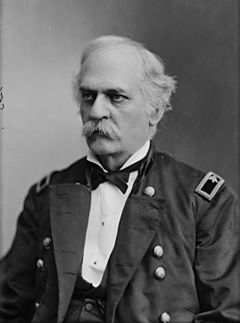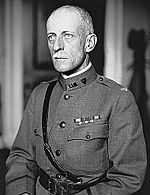Benjamin Alvord (mathematician) facts for kids
Quick facts for kids
Benjamin Alvord
|
|
|---|---|

Brigadier General Benjamin Alvord
|
|
| Born | August 18, 1813 Rutland, Vermont |
| Died | October 16, 1884 (aged 71) Washington, D.C. |
| Place of burial |
Evergreen Cemetery, Rutland, Vermont
|
| Allegiance | United States of America Union |
| Service/ |
United States Army Union Army |
| Years of service | 1833–1880 |
| Rank | |
| Unit | 4th U.S. Infantry |
| Commands held | District of Oregon Paymaster-General of the United States Army |
| Battles/wars | Indian Wars American Civil War |
Benjamin Alvord was an amazing American who lived from 1813 to 1884. He was a soldier, a talented mathematician, and even a botanist who studied plants. He served in the United States Army for many years. He fought in several wars and later became a high-ranking general. Alvord also made important discoveries in math and about plants.
Contents
Early Life and Military Start
Where Did Benjamin Alvord Grow Up?
Benjamin Alvord was born in a town called Rutland, in Vermont. From a young age, he loved nature and exploring the outdoors. This interest would stay with him throughout his life.
How Did He Become a Soldier?
Alvord attended the United States Military Academy, also known as West Point. This is a famous school for training army officers. He showed a great talent for mathematics there. He finished his studies and graduated in 1833.
What Was His First Army Job?
After graduating, Alvord joined the 4th U.S. Infantry. This was a foot soldier unit. He took part in the Seminole Wars, which were conflicts with Native American tribes.
Did He Teach at West Point?
Yes, Alvord returned to West Point. He worked as an assistant professor, teaching mathematics. He taught there until 1839. After that, he went back to serve with the 4th Infantry. He spent 21 years of his army career with this same regiment.
What Did He Do Before the Mexican War?
Alvord had many different duties. He served on the frontier, at army bases, and as an engineer. In 1846, he helped with the military presence in the new state of Texas.
What Was His Role in the Mexican-American War?
Alvord fought in the Mexican–American War. He was recognized for his bravery in battle. He was promoted to captain and then to major for his courage. He fought in important battles like the Battle of Palo Alto and the Battle of Resaca de la Palma. In 1847, he was a chief of staff for a group of soldiers marching from Vera Cruz to Mexico City.
What Did He Do After the Mexican War?
After the war, Alvord changed roles. He became a paymaster, which meant he handled the army's money. He was promoted to major in this new role. He was sent to different places, including the West Coast with the 4th Infantry. He also helped build a military road in southern Oregon. From 1854 to 1862, he was the chief paymaster in Oregon.
Civil War Service
What Was His Job During the Civil War?
From 1862 to 1865, during the American Civil War, Alvord was stationed at Fort Vancouver. He was the commander of the District of Oregon. This was a very large area, covering what is now Oregon, Washington, and Idaho. He held the rank of brigadier general.
Why Was He Chosen for This Role?
General George Wright, who was in charge of the Pacific region, chose Alvord. Wright wanted an experienced officer to lead this important district. The area was still developing and sometimes had problems between settlers and Native American groups.
What Challenges Did He Face?
As commander, Alvord worked to strengthen defenses. He improved the forts near the mouth of the Columbia River. However, he couldn't do the same for Puget Sound. He also faced challenges with getting enough soldiers. Oregon and Washington had low numbers of people joining the army. Alvord supported a military draft to get more soldiers. He also thought paying bonuses might help.
When Did His Command End?
Alvord was removed from his command in March 1865. He was then sent to the East Coast. There, he left his volunteer general position. He became a paymaster again, working in New York City.
Alvord's Math Discoveries
What Math Problems Interested Him?
Benjamin Alvord was very interested in a classic math problem. This problem is about finding a circle that touches three other circles. He also looked at similar problems involving spheres.
In 1855, he published some of his findings. This was in a scientific journal called Smithsonian Contributions to Knowledge.
What Happened to His Later Work?
While stationed at Fort Vancouver, he kept working on his math problems. He sent his new findings in 1860. But sadly, a fire destroyed his manuscript in 1865. This happened when the Smithsonian building caught fire.
Did He Ever Publish It Again?
Yes, he did! In 1882, he found that there are many ways circles and spheres can touch each other. For example, he found 96 circles that cut four given circles at a certain angle. He also found 640 spheres that cut five given spheres at a certain angle. He put all his results together for an article in the American Journal of Mathematics. He explained the delay due to the fire.
After the Civil War
What Was His Career After the War?
After the Civil War, Alvord continued as a paymaster. He worked in Omaha and then for the Department of the Platte. In 1872, he became the Paymaster General of the entire Army. This was a very important role. He served in this position until he retired in 1880. He was promoted to brigadier general in 1876.
What Else Did He Study?
Alvord also loved natural history. He wrote the first scientific description of the compass plant (Silphium laciniatum). This plant is special because it can orient itself in a north-south direction. He also wrote about how animals graze in the Rocky Mountains during winter. Alvord wrote for Harper's Magazine and was a member of the Literary Society of Washington.
Family Life
Benjamin Alvord married Emily Louise Mussey in 1846. They had six children together. His son, Benjamin Alvord, Jr., also became a soldier. He was a general in World War I. His daughter Louise married Thomas Craig. Thomas Craig was a main mathematics professor at Johns Hopkins University.
Death and Legacy
Benjamin Alvord passed away on October 16, 1884, in Washington, D.C. He and his wife, Emily Louise Mussey, are buried in Evergreen Cemetery in Rutland, Vermont.
Two places in Oregon are named in his honor. These are Alvord Valley and the Alvord Desert.


